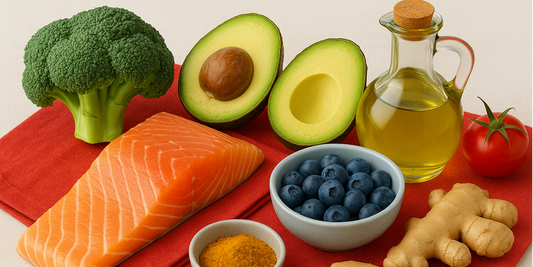
The Best Fruits for a Low-Carb, Low-Sugar Diet
Share
Exploring the sugar in your favorite fruits.
Is the sugar in fruit keeping you unhealthy or far from your fitness goals? The truth? Probably not.
Yes, fruit contains naturally occurring sugar – that is why it’s called nature’s candy. However, that doesn’t mean it has the same effects on your body as a bowl of ice cream or a slice of cake.
Whether you’re keeping an eye on your blood sugar or just want to know which fruits can help lower your overall carb intake, this list will come in handy! From nutrition facts to learning the difference between fruit and added sugar, here is what you need to know.
Is the Sugar in Fruit Good or Bad?
Believe it or not, not all sugar is created equal. The sugar in fruits occurs naturally, so it’s better suited for human consumption. In simple terms, it is better for the body than cakes, cookies, and candy. Additionally, fruit is an integral part of a well-balanced diet as it contains many vitamins and minerals needed to keep you healthy.
Essentially, the sugar found in fruit, which is fructose, is absorbed by the bloodstream at a slower pace. Refined sugar, like the varieties found in processed foods, requires little breakdown when they enter the body. This causes a blood sugar spike, which disrupts the balance of insulin and blood sugar in your body.
The Sweetness Spectrum: Which Fruits Are High in Sugar?
Rather than spend the rest of your next grocery store trip searching nutrition facts for grams of sugar, look at the list below to determine which fruits are best for those trying to manage their blood sugar or take a low-carbs approach to their diets.

Apples
While there are many different varieties of apples, their sugar content usually amounts to about 25 grams per large apple. Although they have higher sugar content, they are also high in fiber, which is excellent for digestion.

Bananas
Did you know the ripeness of a banana determines how much sugar it contains? Green bananas have less sugar than ripe or yellow bananas. One average-sized, ripe banana has a little over 15 grams of sugar.

Berries
The great news about berries is that they are delicious, packed with vitamins, and low in sugar. Strawberries, raspberries, and blackberries have about seven to eight grams of sugar per cup. On the other hand, blueberries pack a heavier sugar punch with around 15 grams per cup, but they don’t strongly affect blood sugar.

Cherries
Cherries are a fan-favorite for summer fruits – and what’s not to love? They’re sweet, delicious, and refreshing. A cup of this summer snack contains 18 grams of sugar. A good way to enjoy cherries without consuming too much sugar is simply by measuring your serving before eating.

Watermelon
Watermelon is a bit high in sugar but also low-carb – making it a guilt-free summer staple. Thanks to its high water content, eating watermelon is also a great way to stay hydrated while keeping your blood sugar in check.

Pineapple
Pineapple is a versatile fruit that is great on its own, in smoothies, and even as an addition to cakes and other desserts. One of the things that makes this tropical fruit so delicious and irresistible is its sticky sweetness. Unfortunately, pineapple’s sticky texture is because of its sugar content – 16.3 grams per cup.

Grapes
Grapes are not only delicious on their own but also make a fantastic addition to salads, yogurts, and much more. While they are quite high in sugar (about 23 grams per cup), they have many nutritional benefits. They are packed with vitamins that support bone health and, when enjoyed in moderation, are much healthier than processed foods when you crave a sweet treat.

Oranges
Orange juice may be packed with added sugars, but its source fruit tells a bit of a different story. One large orange contains about 17 grams of sugar – a bit more than most citrus fruits. Luckily, the fiber in oranges helps slow the release of sugar into your blood, making it less impactful on blood sugar. But if you want to enjoy the taste of an orange in a healthy way, stay away from the juice.

Cantaloupe
Cantaloupe, like watermelon, is a light and refreshing fruit typically enjoyed in the warmer months. Despite its mild and sweet flavor, a cup of cantaloupe contains about 12 grams of sugar. While it certainly doesn’t have the lowest amount of sugar on this list, it’s a rather moderate amount of sugar and can be enjoyed as part of a healthy and well-balanced diet.

Mangoes
Mangoes are one of the more sugary fruits on the list, but that doesn’t mean you can’t enjoy them in moderation and as a part of a healthy approach to eating. One mango has 46 grams of sugar – which could quickly spike your blood sugar. If you’re craving this tropical staple, have a few slices and save the rest for later.

Pears
Pears have a similar composition to apples regarding nutrition and sugar. While they are a bit higher in sugar than some other fruits on this list, they also contain fiber and other vitamins that are good for your overall health! A medium pear contains a little more than 17 grams of sugar. If that’s more than you’d prefer to eat at once, try adding a few slices to your salad or yogurt.

Grapefruit
Grapefruit is a fantastic choice if you’re trying to manage your blood sugar or want to stick to a low-carb diet. This citrusy fruit taste more tart than sweet, but it has a great balance of flavor. Because there are only about eight grams of sugar in an entire grapefruit, you can enjoy them without too much guilt or worry.
In Conclusion
Like any other whole food, fruit is meant to be enjoyed while providing valuable and vital nutrition to your body. Yes, it contains sugar. However, it is crucial to understand that the sugar found in fruits does not have the same adverse effects as the refined sugar found in many of today’s packaged and processed treats. Just remember to consume fruits with a high sugar content in moderation and enjoy the sweetness of nature’s candy!



